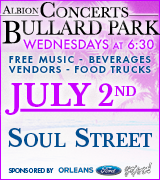Erie County gets more restrictive orange zone, while part of Niagara designated yellow
Orleans and Genesee so far avoid micro-cluster designation
Gov. Andrew Cuomo today announced the yellow micro-cluster zone designated in Erie County last week will become a more restrictive orange zone beginning on Friday, while the rest of the county is on the precautionary yellow zone.
The governor also announced that North Tonawanda in Niagara County is now designated in a yellow micro-cluster zone.
Orleans and Genesee counties, which have seen Covid cases surge in recent weeks so far have not been declared micro-cluster zones which have more restrictions from the state to try to slow the Covid spread.
The Orange Zone in Erie County includes the City of Buffalo, City of Lackawanna, City on Tonawanda, and towns of Amherst, Aurora, Cheektowaga, Clarence, Eden, Elma, Evans, Grand Island, Hamburg, Lancaster, Orchard Park, Tonawanda and West Seneca.
The rest of Erie County is in a Yellow Zone, which includes Alden, Boston, Brant, Colden, Collins, Concord, Holland, Marilla, Newstead, North Collins, Sardinia and Wales.
The new restrictions in the zones are effective on Friday for businesses and on Monday for schools.
Cuomo said Western New York is currently “the worst situation in the State of New York.” The Finger Lakes Region, which includes Orleans and Genesee, also is seeing a big rise in Covid cases and hospitalizations.
Cuomo said the micro-cluster approach has worked, restricted activities in targeted areas with high Covid spread, rather than blanketing an entire region with the more severe restrictions.
Cuomo cited Broome County and Orange County as yellow zones that have gone back to normal. Brooklyn was an orange zone that is going to a less-restrictive yellow zone.
Yellow Zone restrictions
- Non-residential gatherings limited to 25 people, inside and outdoors.
- Residential gatherings capped at 10 people, inside and outside.
- Houses of worship, limited to 50 percent of maximum capacity.
- Businesses all open.
- Dining limited to 4 people per table, inside and outside, with bars and restaurants closing at 10 p.m. for on-premises consumption.
- Schools remain open with 20 percent of in-person students and staff tested each week.
Orange Zone restrictions
- Non-essential gatherings are limited to 10 people.
- Certain non-essential businesses need to reduce in-person by 100 percent. Those businesses with a higher risk for transmitting Covid-19 include gyms, fitness centers or classes, barbers, hair salons, spas, tattoos or piercing parlors, nail technicians and nail salons, cosmetologists, estheticians, and all other personal care services.
- Houses of worship are limited to a maximum capacity of 33 percent maximum occupancy or 25 people, whichever is fewer
- Any restaurant or tavern won’t be allowed to serve patrons food or beverage on premises but may be open for takeout or delivery, and provide outdoor service (as long as no seated group exceeds four people).
- Schools are remote-only and closed for in-person classes
Red Zone restrictions
- Non-residential gatherings prohibited.
- Residential gatherings prohibited.
- Houses of worship will be the lesser of a 10-person maximum or 25 percent of maximum occupancy.
- Non-essential businesses are closed.
- Dining is limited to takeout or delivery only.
- Schools are closed except for remote only.





































































